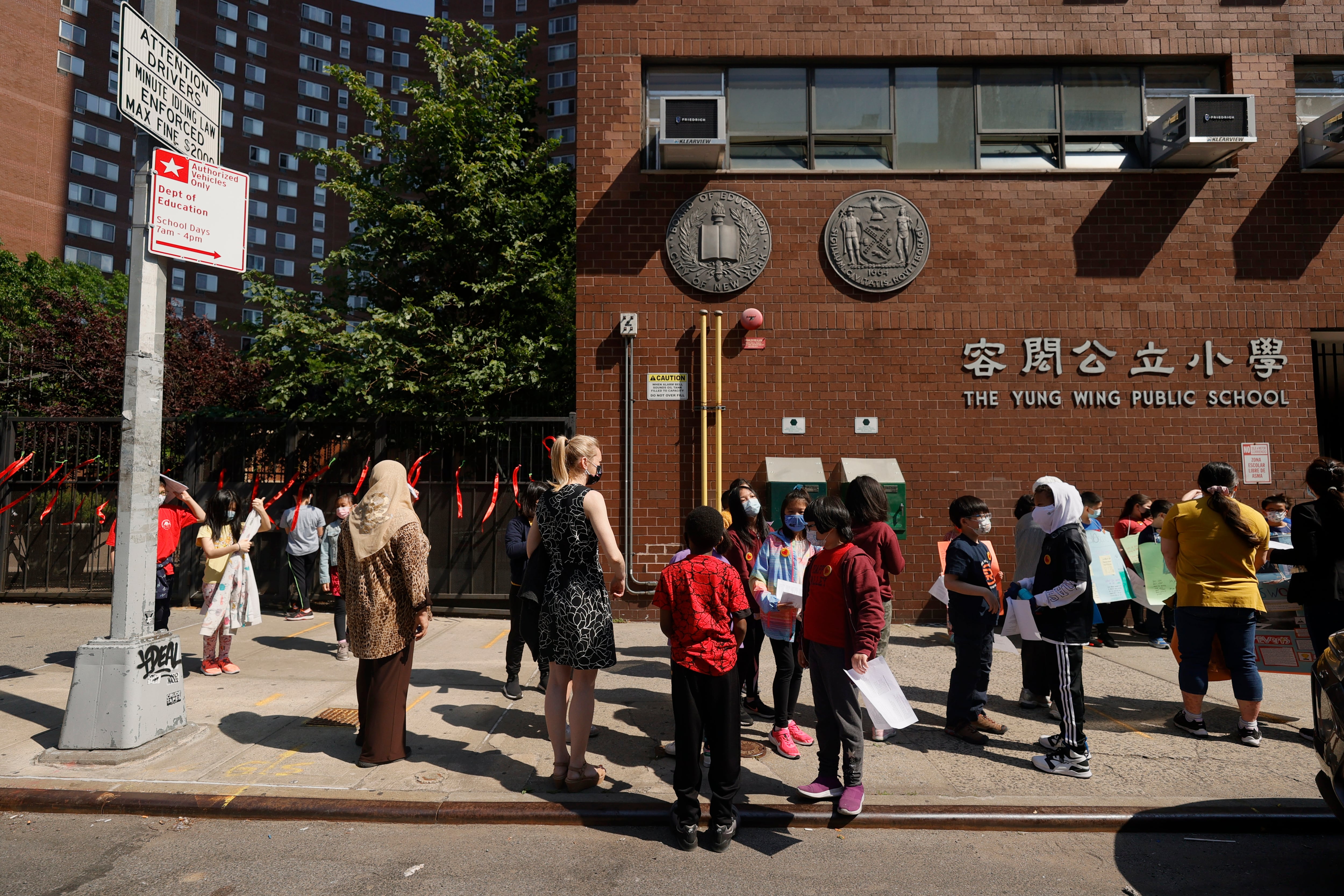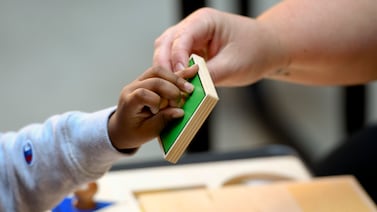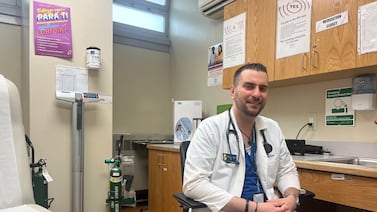This story initially appeared in the Hechinger Report on Sept. 19, 2022.
There’s a new look to history classes in New York City schools: a curriculum in Asian American and Pacific Islander history. Its creators say they’ve felt a a surge of support, in part because the idea could provide long-term solutions to help combat the extraordinary rise in hate crimes targeting all Asian Americans seen since the beginning of the pandemic. It could also help resolve the internal conflicts that many Asian Americans experience when dealing with their sense of identity.
New York City’s Department of Education is the latest public school system to require that U.S. history instruction include an Asian American and Pacific Islander K-12 curriculum. The program will be piloted this fall at selected schools and fully rolled-out in over 1,800 schools by the spring. The curriculum is part of the Hidden Voices Project, initiated by the New York City Department of Education’s Social Studies Department and the Museum of the City of New York.
New York City Schools join seven states that now require Asian American and Pacific Islander studies and 15 states that have recently introduced legislation creating these requirements, according to a recent study by The Committee of 100, a nonpartisan group promoting the full participation of Chinese Americans in U.S. society. But many hurdles must still be overcome by lawmakers and policymakers, before they can assess the effectiveness of the curriculum and its impact, if any, on healing societal wounds.
One way to measure this impact is by involving students in conversation circles and listening to what they say.
To get a sense of how students in New York feel about these changes, The Hechinger Report spoke with six public school students, representing four of the city’s five boroughs, whose heritage is Asian American or Pacific Islander. Despite living in neighborhoods that are predominantly Asian, or associating primarily with other Asian Americans at school, the students said they were taught little — if anything — about their history at school.
These students want more than good intentions from the new program; they want to hold the education system accountable for producing measurable results.
For many of today’s students, the new program’s ideas and approaches to rethinking history and how it is taught are not radical. This generation is hyper-aware of the way that history has been framed — what is included and what is left out. In the absence of detailed information about Asian American history at school, they’re teaching themselves through social media — such as videos on Tik Tok and infographics on Instagram — and their networks of friends. They have witnessed firsthand the misrepresentation of that history, in interactions in which Asian Americans are held to often harmful stereotypes
Now, they say, it’s time for their history classes, educators and textbooks to catch up.
Kellen Zeng
There was something about the way history was taught at Staten Island Technical High School that disturbed Kellen Zeng, 18, of Staten Island. The students were asked to role-play during class. She presented her “witness testimony” as a Chinese war victim, accusing her classmate, who played Genghis Khan, of crimes against humanity. She couldn’t quite put her finger on what was wrong with it. It felt silly. She felt incredibly uncomfortable.
Although students seemed to enjoy the school-wide production, Zeng was embarrassed. “It was hilarious because some students actually dressed up and brought in Chinese hairpins and clothing from their heritage — the whole school got really into it,” Zeng said. Years later, as a rising sophomore in college, she began to understand why the spectacle was so problematic.
“At the time we all thought it was funny, but looking back on it, it was a very questionable way to teach history — we were graded based on our performances,” Zeng said.
Zeng grew up in the Bensonhurst area of New York — commonly referred to as “Brooklyn’s Chinatown” — with a supportive community of Asian American family members, neighbors, and friends. When she moved to and went to high school in Staten Island, where the population is less than 10 percent Asian American, her school remained more than half Asian. Zeng and her friends never really ventured outside their Asian American bubble.
For Zeng, it was clear that the problems with the way world history was taught at her school bled through into the teaching of U.S. history.
“We can undo our idea of the perpetual foreigner by teaching and talking about Asian American accomplishments and contributions to the growth of the United States, but we must also acknowledge the United States’ own role in shaping the harmful, dominant narrative that has been created,” Zeng said.
To change the way this history is taught, instruction must place Eurocentric perspectives of world history under a critical lens, Zeng said. A more inclusive U.S. history curriculum will help Asian American students find strength within their own dual identities. They will no longer be made to feel like they don’t belong, she said.
“This new Asian American curriculum will only be helpful if it gets taught ‘right’,” Zeng said.
Humayra Nasita
“I want people to stop telling me ‘You’re not Asian’. I want people to stop assuming that I’m Indian,” said Humayra Nasita, 17, who is from Bangladesh. “I just want to be recognized and feel seen by my classmates.”
Nasita said there are many facets to her identity: She is Asian American, South Asian American, Bengali, brown-skinned and Muslim. She is a high school senior, a Queens native, and a K-drama fan. But she has always felt the most marginalized of her identities is being Bengali.
Although she lives in Jackson Heights, a diverse neighborhood in Queens, and attends Benjamin N. Cardozo High School, where white students make up just 11 percent of the population, Nasita finds her identity excluded. Bangladesh’s existence wasn’t even acknowledged in her history classes.
In 2019, 53,291 Bangladeshis made up just 6.3 percent of the population of Asian American and Pacific Islander immigrants living in New York City. Nationwide, Bangladeshis comprise a much smaller share of the Asian American population; almost 40 percent of all Bangladeshis in the U.S. live in New York City.”
Nasita wishes she had been taught about the history of Bengal, the province that later became Bangladesh. In particular, she wished she had been taught about the Partition of India in 1947, when India and Pakistan were divided into two countries, and Indian Bengal — and many of its Bengali people — was assigned to distant Pakistan. Decades later it became an independent nation. To Nasita, these events in world history must be covered first, to understand how and why Bangladeshis immigrated to America.
Although the new curriculum will include Bengali representation for the first time, Nasita remains skeptical. Recently, she was enraged by broken promises made by politicians purporting to fight for educational funding. Members of her community had supported Shahana Hanif, a city council member who was one among many who voted in favor of Mayor Eric Adams’ budget, with its cuts to educational programs.
“Yes, we need representation — but we actually need much more than that,” Nasita said. “We need funding.”
Karen Kong
Karen Kong, 16, has unwavering pride in her Chinese American heritage, rooted in her sense of family and honor. Relying heavily on her parents and maintaining strong connections with her family is how she feels the most “Asian.”
Kong’s father immigrated from Hong Kong over 40 years ago and settled in Manhattan. He started working as a truck driver — a job that he holds currently. After marrying her father, Karen’s mother came later from Jiangmen, China, and took a job as a home health-care provider. While her father is fluent in English, her mother experienced some difficulties with the language. The couple moved to Sunset Park, and moved again to Dyker Heights when Kong was 10 years old.
In the last two years, Kong has learned that Asian American issues are very real and that they need actionable solutions. As Asian Americans have increasingly become a target for hate crimes during the pandemic — blamed for the allegedly “Chinese” virus — she worries about commuting on subways. But she’s more concerned for her parents’ safety than her own.
To Kong, the new history curriculum will be effective only if instruction on Asian Americans and their histories becomes more explicit. Avoiding conflict and dancing around traumatic topics would result in stagnant perceptions, she said.
Kong will be a junior taking U.S. history next year, where she hopes Asian American history will be taken seriously for the first time. “In order for history to not repeat itself, the tone is very important in the way that history is taught,” said Kong. “We need to bring heaviness and severity to these topics, so they are no longer taken lightly.”
Raylan Li
Raylan Li, 15, is excited to become a co-president of the Asian Culture Club this fall. A student at the N.Y.C. Lab High School for Collaborative Studies, Li sees a noticeable difference between the predominantly Asian elementary school he attended in Manhattan’s Chinatown, and middle school and high school, where the student population is predominantly white.
As he got older, fewer history classes highlighted Asian Americans.
“I went from visiting the Museum of Chinese in America (MoCA) to learning mostly about the Civil War,” he said.
At his high school, he recalled how the lack of diversity in staff and teachers influenced him.
One day, a substitute teacher came up to his desk, asking him if he had completed his work. When he explained that he had already finished next week’s, she began to go on about “how much he loved math.” He wasn’t even in math class — he was in Spanish. Then she praised the book “American Born Chinese”.
He stared at her blankly.
“Yeah, I actually haven’t read it,” he said.
She didn’t stop. She tried to bring a Chinese girl who was sitting at Li’s table into the conversation.
“It was so awkward,” Li said.
While Li didn’t think the substitute’s intentions were hostile, he thought the school should do better. But he doesn’t necessarily blame her — he understands that teachers are constantly learning too.
Because of this, Li agrees it is important to retrain teachers and offer professional development classes on changing attitudes towards people of color.
“I haven’t really had the space to talk about what it means to be Asian. But I think this initiative could help eliminate Asian American erasure from the education system, by giving us more visibility,” said Li.
Katie Chen
“If you see something, say something” sing the overhead speaker announcements, which are New York City subway commuter gospel. But Katie Chen, 21, is more familiar with, “If you see something, keep your head down, and say nothing” — an adage her parents have passed down to her.
Chen believes that any person of color can relate to this message. The security afforded most white people is in stark contrast to the experiences of people of color, who, like her, are told to be cautious, and not take safety for granted.
Chen favors a focus on inter-relationships as a method of approaching the history curriculum, an approach identified as ‘intersectionality’ by groups such as the Coalition for Asian American Children and Families (CACF).
Members of CACF’s Asian American Student Advocacy Project (ASAP), were some of the first students to get the attention of the New York City Department of Education and start the process toward reinventing the curriculum. Currently, ASAP members are working with department of education officials, offering student feedback on the curriculum.
“Addressing intersectionality means learning about how communities have come together to support one another, in addition to how communities have been historically divided,” said, Kaveri Sengupta, CACF’s Senior Policy Coordinator for Education.
There are many opportunities for intersectionality to be applied to the curriculum, said Sengupta. It can mean discussing the shared experiences of American immigrant communities, as well as how these experiences differed. Or it can mean covering the solidarity between marginalized groups, as when Asian Americans supported Black activists and were simultaneously influenced by Black activism to pursue their own civil rights movement in the 1960s and ‘70s.
“The harmful impact of not including intersectionality and only talking about Asian American accomplishments in the curriculum is that this will only reinforce the model minority myth,” Sengupta said.
Chen stressed the importance of understanding the issues faced by other communities. “All people of color – Black people, Asian people, Hispanic people, Indigenous people – we need to support one another to build allyship and understanding,” Chen said.
“It’s about my connection with family members and my culture. As a first-generation American-born Asian in my family, the language barrier between me and my grandparents makes it very difficult for me to communicate with them. As I grow older and lose part of my mother tongue, I find it harder to express my emotions. I connect this to time because I feel like the family bond and the culture I’m carrying to the next generation is all going to fade away in the future. I’m in a position where I’m stuck with either relearning my language or moving on with my life. In the painting, the person sitting on the hourglass is me staring into the darkness in a clock tower. Though I’m guilty of losing my mother tongue, I’m in a place where I don’t know how I’m going to reclaim my culture”
This story about Asian American history was produced by The Hechinger Report, a nonprofit, independent news organization focused on inequality and innovation in education. Sign up for the Hechinger newsletter.






